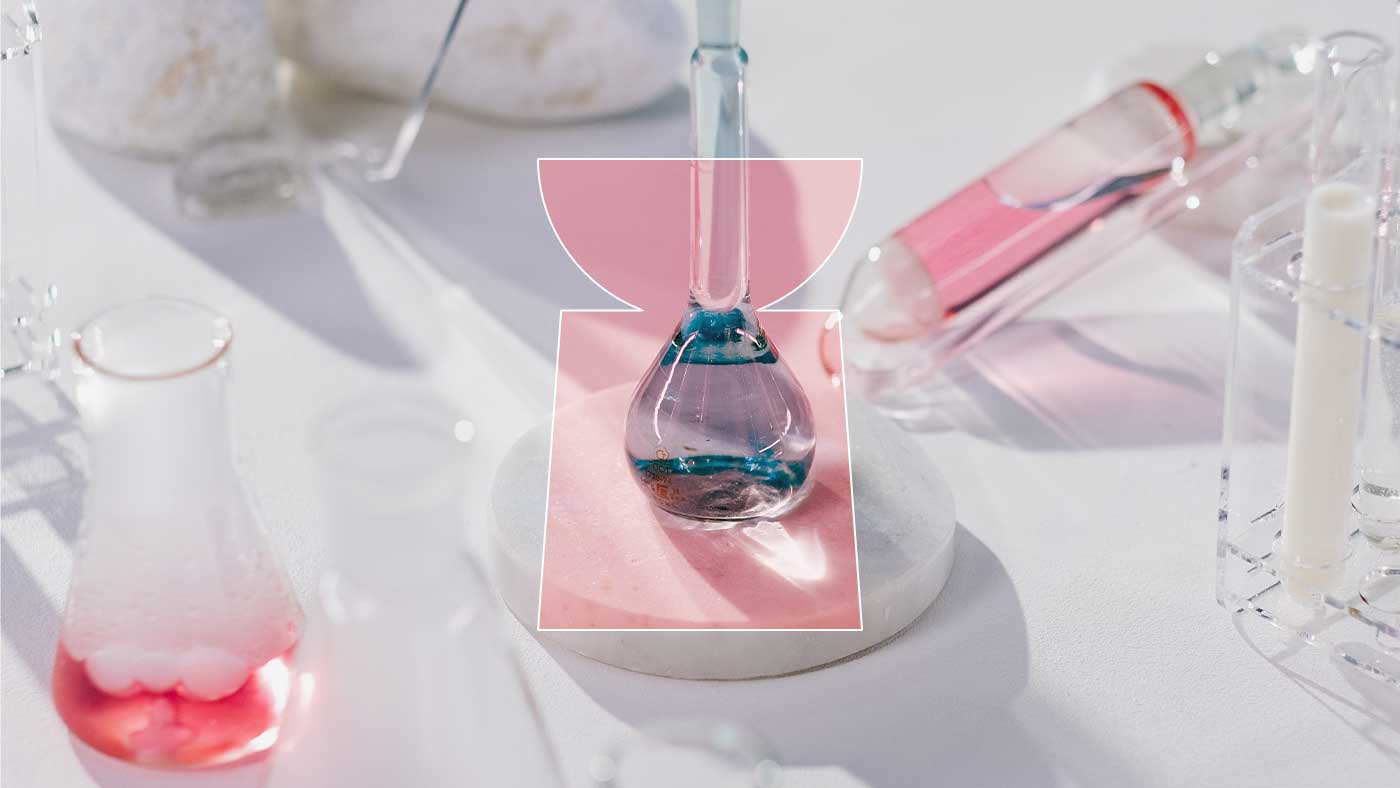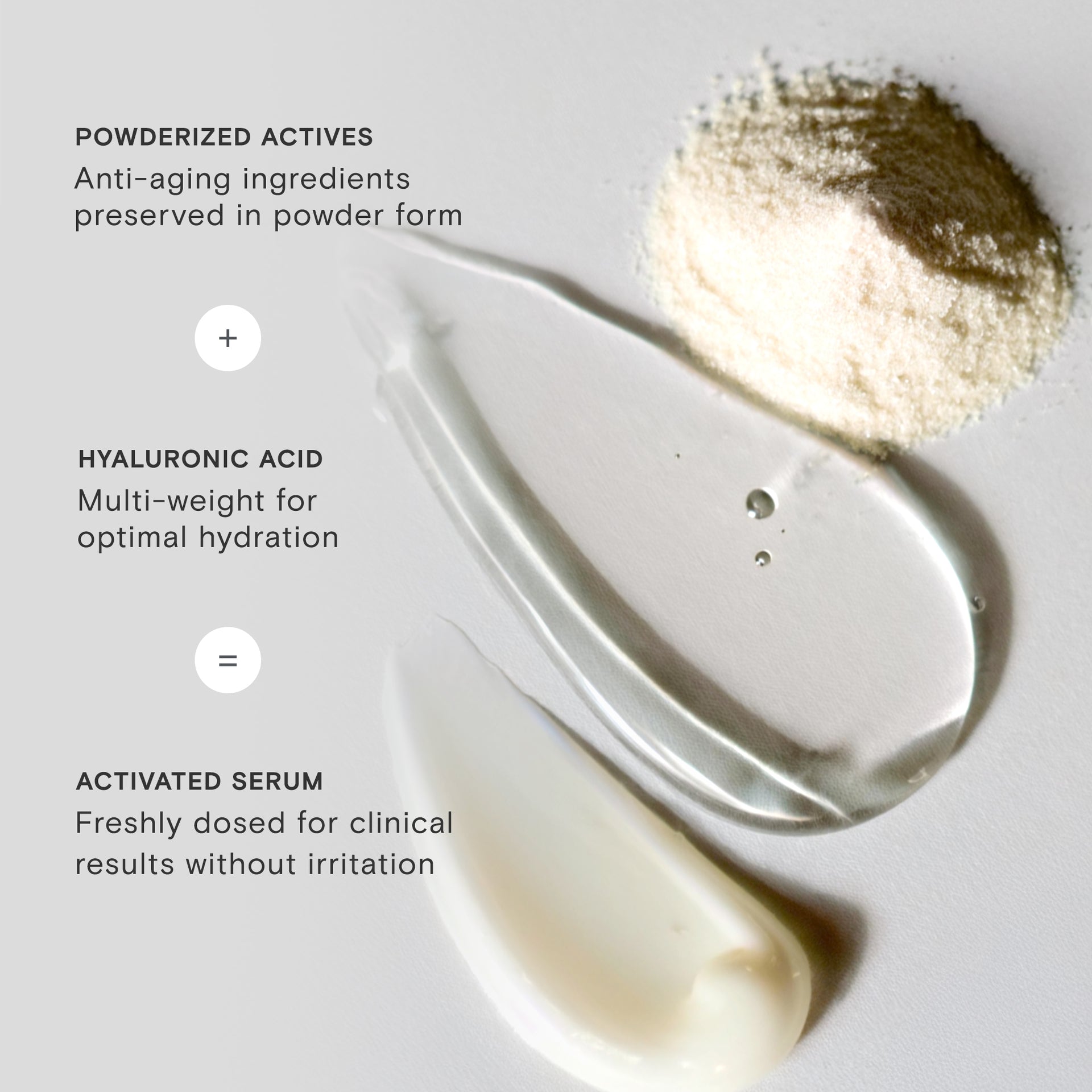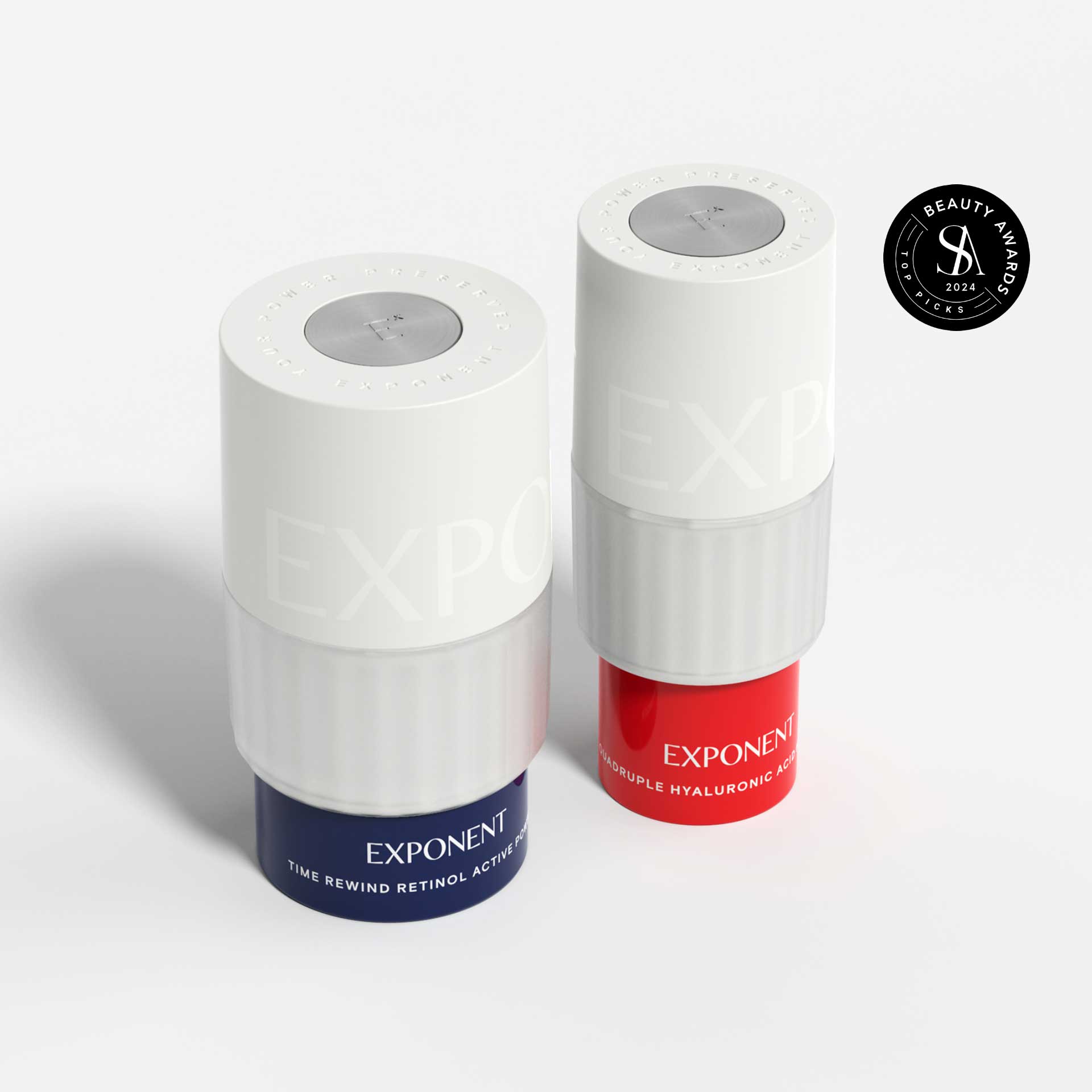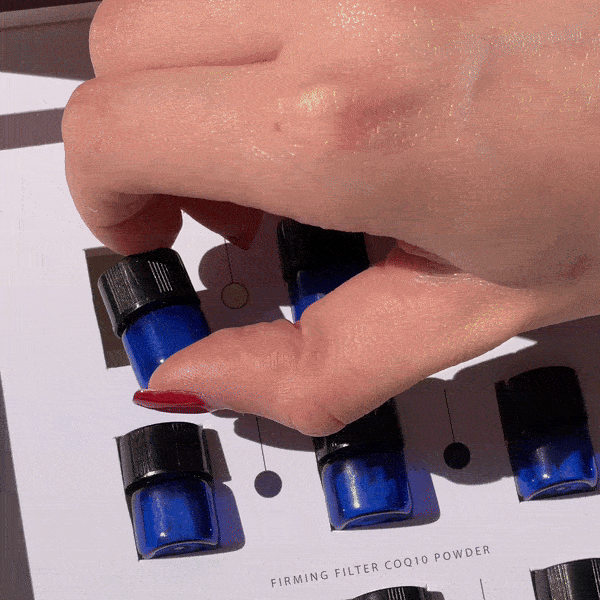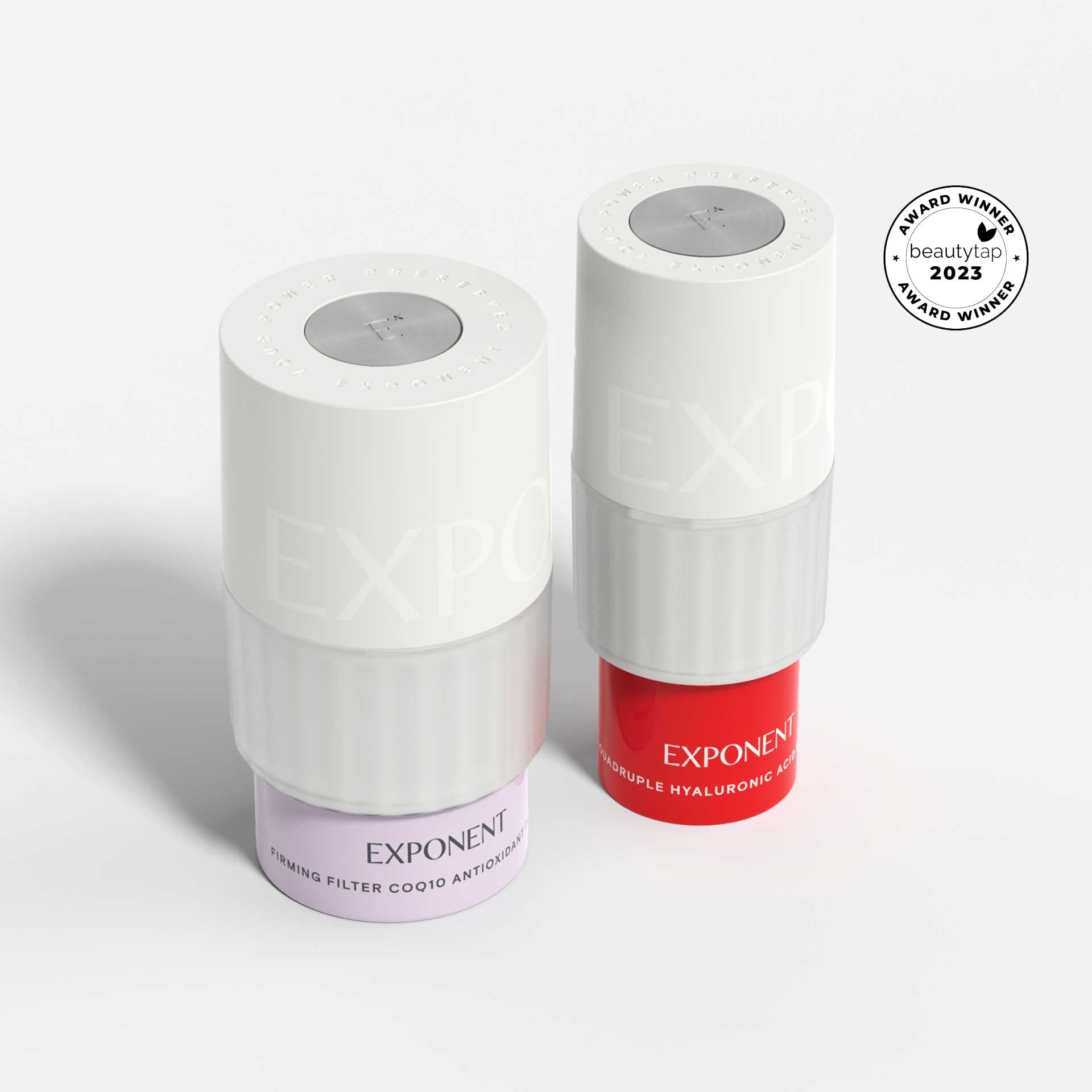When it comes to skincare, we’re inundated with “the next best thing.” One day it’s a rare nut oil from the rainforest, the next it’s an ectodermal peptide from a lab. While these discoveries blast inboxes, only a few ingredients are actually legit — clinically proven to show benefits for the skin by a third party. By third party, we mean independent lab testing by chemists and medical professionals, published in scientific journals. No fluff stuff.
THE LEGIT LIST
12 scientifically tested skincare ingredients. We recommend your products contain at least 1.
1. VITAMIN C
Vitamin C, also called ascorbic acid or L-ascorbic acid, is a vitamin that isn’t actually produced by the body. Instead, the only way to get it is through supplements or your diet — citrus fruits like oranges are famously rich in vitamin C. While you can certainly eat your way to a healthy vitamin C intake, your skin in particular reaps the biggest benefits when it’s applied topically versus ingested. “Topically, it’s 20 times more potent than the oral intake,” says Dr. Patricia Wexler, a dermatologist in New York City.[1]

What does pure Vitamin C do?
Vitamin C promotes collagen production, which has the potential to thicken the dermis, diminish fine lines, and is essential for firm, youthful skin,” Wexler says. On top of that, vitamin C is an antioxidant, meaning it protects skin cells from damaging free radicals caused by UV exposure.
What are the benefits of ascorbic acid Vitamin C?
While Vitamin C is best known for its skin brightening super power, it's a jack of all trades. Vitamin C accelerates collagen and elastin production, making it an anti-aging essential, and helps to reduce wrinkles, hyperpigmentation, and aid wound healing.[2] Vitamin C is also necessary for the growth, development, and repair of all body tissues, the proper functioning of the immune system, iron absorption, and the maintenance of cartilage, bones, and teeth.[3]
Is ascorbic acid good for your face?
100 percent! However, ascorbic acid is an incredibly unstable ingredient and breaks down quickly and continuously when exposed to air, light, or water. Once you open a Vitamin C serum, it's important to use it within 6 weeks while it's still active.
How do you use Vitamin C (L-ascorbic acid)?
Like all good things, Vitamin C only lives up to its super-ingredient greatness if it’s the real deal — pure, potent, and has enough to pack a punch. With an effective concentration at 5% - 20%, here's the breakdown on which percentage is right for you.

MEANINGFUL CONCENTRATION
15% — CLINICALLY PROVEN TO HAVE BENEFIT BUT CAN OFTEN BE IRRITATING
You have a high Vitamin C concentration but if you’re a new user, you might want to patch test for sensitivity.[4]
10% — CLINICALLY PROVEN TO HAVE THE OPTIMAL BENEFIT
The ideal amount of Vitamin C for the most skin benefit. Be sure to use it within 4 weeks to prevent further degradation of potency.
5% — CLINICALLY PROVEN TO HAVE MODERATE BENEFIT
A good starter amount for a first time user or someone with sensitive skin.[5]
2. SALICYLIC ACID
What does salicylic acid do to the skin?
When applied to the skin, salicylic acid may work by helping the skin to shed dead cells from the top layer and by decreasing redness and swelling (inflammation). This decreases the number of pimples that form and speeds healing.
What can salicylic acid be used for?
Salicylic acid is used to treat mild to moderate acne. It reduces swelling and redness and unplugs blocked skin pores, allowing pimples to shrink. It also treats skin conditions like psoriasis by softening and loosening dry, scaly, or thickened skin so that it falls off or can be removed easily.[6]

Is willow bark the same as salicylic acid?
Willow bark contains salicin, which is where salicylic acid comes from. The salicylic acid found in skincare products is the metabolized derivative. Willow bark extract has been shown to produce similar results to synthetic salicylic acid, except without some of the drawbacks. Even in small concentrations of 0.5% to 1%, salicylic acid may cause irritation, redness, flaking, and dryness. Those with sensitive skin may actually break out more because of salicylic acid. On the other hand, salicin in willow bark extract is a much gentler version of salicylic acid.
Studies have found that even at a level of 100%, which is equivalent to 10% formulation of salicylic acid, salicin is non-irritating. However, the exfoliative and skin rejuvenating properties of willow bark extract compared to salicylic acid are less effective for treating acne and exfoliating the skin. Nonetheless, willow bark extract can provide skin benefits, such as anti-inflammatory and antioxidative properties.[7]
3. RETINOL
Topical vitamin A–based drugs called retinoids — the most used and most studied anti-aging compounds — may reduce fine lines and wrinkles.
Rather than remove dead skin cells on the skin's surface, the small molecules that make up retinol go deep beneath the outer layer (epidermis) to the middle layer (dermis), making it a prime ingredient for treating acne and aging skin.
Once in the dermis, retinol helps neutralize free radicals to boost the production of elastin and collagen. This creates a “plumping” effect that reduces the appearance of fine lines, wrinkles, and enlarged pores. While plumping it also has an exfoliating effect that can further improve skin texture and tone.
Other names for Retinol:
- Retinyl Acetate (the naturally occurring form of retinol)
- Retinyl Palmitate (synthetic retinol)
- Retinaldehyde (synthetic retinol)
- Propionic Acid
What does retinol do to your face?
While retinoids reduce fine lines and wrinkles by increasing the production of collagen, they also stimulate the production of new blood vessels in the skin, which improves skin color. Additional benefits include fading age spots and softening rough patches of skin. However, it takes three to six months of regular use before improvements in wrinkles are apparent—and the best results take six to 12 months.
Because retinoids can cause skin dryness and irritation, doctors often recommend using them only every other day at first and then gradually working up to nightly applications. Wear a sunscreen during the day, because retinoids increase the skin's sensitivity to sunlight. These drugs must be used continually to maintain their benefits.[8]
What is retinol used for?
- Retinol is used to fight acne, diminish age spots and other signs of sun damage
- Clears congested pores and fights acne
- Treats hyperpigmentation
- It minimizes pores while also minimizing new breakouts which helps in smoothing and refining the skin texture
How do you use retinol on your face?
Because retinol is so powerful, start slow when introducing it into your skincare routine. Consider incorporating it into your routine every three nights, starting at a low concentration like 0.1 and working your way up to 0.3 once your skin has gotten used to it.

When should you start using retinol?
Being in your mid 20s or early 30s. Thirty has long been the banner year for introducing retinol into one's routine, but many women are starting before then, motivated by early signs of aging, such as sun spots or crows feet, or simply eager to get a head start and utilize the latest technologies — under the careful watch of their dermatologist. "Your mid-twenties are a great time to start using retinol," says Ellen Marmur, M.D. "Many patients who have used it for years swear by it."[9]
4. PEPTIDES
Peptides are short chains of amino acids and the building blocks of proteins such as collagen, elastin, and keratin. These proteins are responsible for texture, tone, elasticity, and firmness that are crucial to the function and appearance of the skin.
What do peptides do to the skin?
Peptides can penetrate the outer layer of the skin, so instead of sitting on top of the skin, they sink in more deeply and can stimulate the body to produce collagen and elastin. Applying peptides consistently to the skin can help to stimulate production at a higher rate than otherwise.[10]
How do peptides work in skincare?
When we age, collagen is destroyed but not replaced. As a result, young smooth skin becomes thin and wrinkled over time. One strategy to improve wrinkles is to replace the lost collagen by “tricking” your skin. When collagen breaks down, it forms specific peptides which act as a signal to tell your skin it was damaged and to make new collagen. Applying peptides directly to your skin is a way to trick your skin into thinking that it has lost collagen recently and needs to make more.[11]
What are the benefits of peptides for skin?
- Anti-aging agent that soften wrinkles and fine lines
- Stimulates collagen production for firmer skin
- Improves the skin barrier and speeds up wound healing
MEANINGFUL CONCENTRATION
0.01% if pure peptide
1% if peptide solution
5. NIACINAMIDE
Also known as vitamin B3, Niacinamide is a water-soluble vitamin that works with the natural substances in your skin to replenish moisture to the skin's barrier by decreasing water loss. It helps build cells in the skin while also protecting them from environmental stresses, such as sunlight, pollution, and toxins.
How does niacinamide help the skin?
Niacinamide is an exceptional multitasker. It helps minimize enlarged pores, regulate oil production, tighten lax pores, improve uneven skin tone, and soften fine lines and wrinkles. In addition, niacinamide strengthens the skin, helps treat rosacea and hyperpigmentation, and diminishes dullness. Niacinamide’s anti-inflammatory properties make it an especially attractive treatment for skin conditions marked by inflammation, like acne.
Can niacinamide be used everyday?
Niacinamide is well tolerated by most people and is recommended twice a day, everyday. While it's an all-season favorite, niacinamide comes in particularly handy during winter months when it's cold and dry and people are using central heating. “Niacinamide is a brilliant all-rounder that the vast majority of people — of all ages and skin types — have no problem tolerating. I rarely see someone who doesn’t get on with it,” says London-based cosmetic dermatologist Dr. Sam Bunting.[12]
MEANINGFUL CONCENTRATION
Niacinamide is effective at 1% - 5%
6. Lactic Acid, Glycolic Acid (Alpha Hydroxy Acids)
Alpha hydroxy acids are water-soluble acids derived from fruits and plants. They’re considered a chemical exfoliant, which means that they use chemicals — aka acids or enzymes — to buff away dead skin cells. Lactic acid and glycolic acid are common AHAs. Depending on the concentration, a product with alpha hydroxy acid may remove dead skin cells from the surface of the skin or exfoliate even deeper, removing the whole outermost layer.
Is lactic acid good for your skin?
Because lactic acid triggers cellular renewal, it's great for achieving a brighter complexion. By increasing cell turnover, it helps eliminate accumulated dead skin cells on the epidermis — the top layer of the skin. After using lactic acid, you'll notice a brighter and smoother complexion. This AHA exfoliant helps treat moderate to severe hyperpigmentation, which happens when certain spots on your skin have more than the normal amount of melanin. It can also fade age spots and reduce the appearance of wrinkles and highly visible pores.
What does lactic acid do for your skin?
Lactic acid as an effective antimicrobial. Some research suggests that lactic acid and probiotic supplements can help with sensitive skin. By teaming up to fix certain inflammatory reactions, they can both give a microbial balance to the skin. While probiotics promote more in-depth regulation by balancing the gut, lactic acid works alongside them as a treatment for moderate skin conditions like psoriasis, eczema, and acne.
- Exfoliates and smoothes skin
- Hydrates dry skin
- Minimizes enlarged pores
- Fades age spots
- Brightens skin/Treats hyperpigmentation
- Helps to firm skin at higher levels
How often can you use lactic acid on your face?
Apply it once per day at night. If your skin is sensitive or if you are new to acids, we recommend starting with Lactic Acid 5% + HA and applying it once per week.
Glycolic acid vs lactic acid - what’s the difference?
The difference is lactic is more gentle, so it's great for those with sensitive skin. It's also very hydrating so you can use it not just on your face but all over your body too. If you're looking for more dramatic results, though, glycolic acid is the way to go.
Which is better glycolic or lactic acid?
When deciding which one to use, consider your skin’s sensitivity. Sensitive skin types, or those dealing with a damaged moisture barrier and experiencing highly irritated skin as a result, might do better with lactic acid.
Lactic acid offers the same benefits as the stronger glycolic acid, but because it has a larger molecule size, it does not penetrate as deeply. People with sensitive skin will find lactic acid to be the gentler acid between the two. Using lactic acid at a 5 percent or 10 percent concentration every few weeks will help you get the results you want in time without irritating your skin to the point of damaging your skin’s barrier.
MEANINGFUL CONCENTRATION
AHAs are effective at 1.5-20%
7. HYALURONIC ACID
What does hyaluronic acid do to your face?
Hyaluronic acid is one of the simplest ways to boost hydration and keep your skin looking and feeling its best. When applied to the skin, hyaluronic acid can significantly decrease the depth of wrinkles and enhance skin firmness and elasticity. It can also reduce redness and and plays a key role in wound healing. Because it has a low chance of side effects and is available in a range of product formulas, hyaluronic acid is ideal for most skin types.

8. GREEN TEA
Green tea is a botanical derived from the leaves and buds of the tea plant Camellia sinensis.
What does green tea extract do for skin?
Increases Moisture
Green tea extract contains polyphenols, such as ECGC, which are effective in protecting against free radicals which may ultimately damage the skin. Specifically, one research study found that applying a solution containing 6% green tea extract to the skin of participants increased moisture over a period of 30 days. This indicates that the extract helps the skin to retain moisture and hydration, restoring overall skin tone when used consistently over a longer period of time.
Reduces Puffiness
Green tea extract and tea bags naturally contain some caffeine which can help reduce puffiness of dark circles and bloating of the face when applied topically. Paired with green tea EGCG’s anti-inflammatory properties, green tea extract is an extremely effective way to reduce swelling and redness of the skin, especially around puffy eyes.
Fights Acne
Green tea extract has antibacterial and astringent properties that can help treat active acne breakouts. The EGCG in Green tea has been shown to reduce sebum production, the oil naturally secreted from the skin’s glands which can clog the pores with dirt and oil. In addition, its exfoliating property helps decrease the appearance and occurrence of blackheads while eliminating dead skin, dirt, bacteria, and other pollutants on the skin’s surface, thus promoting cell renewal for a more clear and healthy appearance.
Is green tea extract good for all skin types?
While green tea extract is an effective treatment for acne and oily skin, this superhero ingredient benefits all skin types. Unless you have a known hypersensitivity to green tea, it can be used for reduce inflammation in skin conditions such as eczema, psoriasis, and dandruff and reduce the signs of sun damage, such as hyperpigmentation, rough texture, and fine lines.
MEANINGFUL CONCENTRATION
Green Tea is effective at 1 – 2.5%
9. RESVERATROL
Resveratrol is a class of plant micronutrients called polyphenols. Polyphenols are organic chemicals that plants make to survive drought or attack from disease and carry a variety of health and skincare benefits.

What does resveratrol do for skin?
Resveratrol can have a two-fold effect, both neutralizing free radicals and boosting antioxidant levels, so your skin can better defend and repair itself. One 2014 study found that topically applying resveratrol significantly improved fine lines, wrinkles, and elasticity in 12 weeks.
Can resveratrol reverse aging?
Resveratrol is highly effective in combating the damaging effect of free radicals that leads to skin aging. It works on a cellular level to fight the process of aging by stimulating healthy cell growth and, thus, promoting collagen production. It also protects the skin from UV damage which accelerates aging skin.
MEANINGFUL CONCENTRATION
Resveratrol is effective at 0.5 – 3%
10. UBIQUINONE
Ubiquinone (also called CoQ10) is an antioxidant that, when applied topically, can help rewind the clock. Dendy Engelman, MD, notes that the powerful antioxidant is involved in a number of biological functions, such as “helping to produce energy, neutralizing free radicals, and keeping cells both inside the body and in the skin healthy.” Specifically, once CoQ10 is absorbed through the skin, it penetrates and nixes the formation of oxidative stress — the not-so-secret culprit of premature aging and skin cancer.
What are the benefits of ubiquinone?
Natural Skin Repair & Regeneration
One of the key benefits of Q10 is that it provides the cells in your skin with the critical energy needed for it to be able to repair and regenerate itself, meaning it is able to better carry out its basic functions.
Creates a Radiant Complexion
With the energy that Q10 is providing skin, it can repair and regenerate at a faster rate, giving skin an energized, radiant appearance. As skin ages, the natural levels of Q10 begin to diminish, and skin can look dull and tired. This is why adding CoQ10 products to your skin care routine can help you maintain a radiant complexion.
Coenzyme Q10 Can Help to Reduce Sun Damage
CoQ10 is a powerful antioxidant that helps to defend skin from adverse effects of sun exposure that are caused by free radicals (unstable atoms that are able to damage skin cells). Reducing sun damage also helps to prevent sun induced signs of aging.
Coenzyme Q10 Helps Prevent Fine Lines & Wrinkles
Coenzyme Q10 helps to support the production of collagen, which helps fight the signs of aging skin such as fine lines and wrinkles.

MEANINGFUL CONCENTRATION
Ubiquinone is effective at 0.3-3%
11. ASIATICOSIDE
What is Asiaticoside?
Centella asiatica is a perennial herb that grows primarily in Asia and is highly regarded for its medicinal, wound healing and skin-soothing properties.
Why Centella is good for skin?
Centella asiatica is a rich source of amino acids and a potent antioxidant that helps revitalize the skin's protective barrier. It's also known to reverse the visible effects of sun damage and works as a hydrating ingredient to soothe upset or compromised skin.

12. SQUALANE
What is squalene vs squalane?
Squalene is one of the many natural lipids your body produces to lubricate and protect your skin. It basically mimics your skin’s natural oils, making it an excellent emollient. Squalane is a derivative of squalene and is much lighter (making it better for acne-prone skin). It also has a longer shelf life than squalene as it does not go through oxidization, which is why it's more commonly used in skincare.
What are the benefits of squalane?
Squalane is a tremendous hydrating ingredient that locks moisture into your skin, helping prevent fine lines, ease dry patches, and give your skin a more vibrant complexion. Squalane also doubles as a powerful dextoxifier and, because it's an antioxidant, it helps protect the skin against free radicals which can accelerate the aging process.
At Exponent, our mission is to set a new standard for effective skincare so you can cut through the clutter and choose products that actually work. And, to get even more from your skincare routine, you can now pair them together using what you've just learned. For skin discoloration and fine lines and wrinkles, use our Brightening Boost Vitamin C System in the morning and Time Rewind Retinol System at night. If sensitive skin is what you're struggling with, pair our Calm Revival Green Tea Resveratrol Serum with the Firming Filter CoQ10 Serum. Or, if you want to prevent dry, flaky skin, the Clear Comeback Probiotic Enzyme Serum stands out.
*Clinical Study details: An independent clinical testing facility ran a 6 week study in which 32 female subjects completed testing. Subjects were evaluated with Visia Image Analysis Pro, Lesion counting with a Board-certified Dermatologist and trained technician. Upon completion of the testing period, data was analyzed and evaluated.
Footnotes
- Deanna, Pai. These vitamin C serums can brighten skin, reduce wrinkles and more. CNN underscored. Updated October 2019. Source
- Zelman, Kathleen M. The Benefits of Vitamin C. Nourish by WebMD. September 2020. Source
- Curtis, Lindsay. Vitamin C Benefits for Skin. VeryWell Health. December 2020. Source
- Philippe G. Humbert. Topical ascorbic acid on photoaged skin. Clinical, topographical and ultrastructural evaluation: double-blind study vs. placebo. Wiley Online Library. June 2003. Source
- John C.Murray MD. A topical antioxidant solution containing vitamins C and E stabilized by ferulic acid provides protection for human skin against damage caused by ultraviolet irradiation. Science Direct. March 2006. Source
- Salicylic Acid Gel. WebMD. Source
- Brooke Shunatona. What's the Difference Between Willow Bark Extract and Salicylic Acid? We Explore. Byrdie. August 2021. Source
- Do retinoids really reduce wrinkles? Health.harvard.edu. October 2019. Source
- Lauren Valenti. 6 Essential Things to Know Before Using Retinol and Retinoids. Vogue. August 2021. Source
- Grace Gallagher. Peptides and Your Skin Care Routine. Healthline. June 2020. Source
- E-medicalclinic.com. Do topical peptides (AKA skincare) work? November 2021. Source
- Amber Voller. Niacinamide: everything you need to know about this super skin ingredient. Stylist.co.uk. Source


